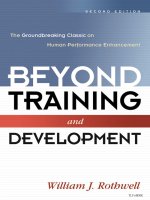Employee training and development 5th chapter 02
Bạn đang xem bản rút gọn của tài liệu. Xem và tải ngay bản đầy đủ của tài liệu tại đây (475.39 KB, 39 trang )
Chapter 2
Strategic Training
McGraw-Hill/Irwin
Copyright © 2010 by the McGraw-Hill Companies, Inc. All rights reserved.
Introduction
Business strategy – a plan that
integrates the company's goals, policies,
and actions.
The strategy influences how the company
uses:
physical capital, financial capital, and human
capital.
Goals – what the company hopes to
achieve in the medium- and long-term
future.
2-2
Introduction (cont.)
Strategy has a particularly strong
influence on determining:
The amount of training devoted to current or
future job skills.
The extent to which training is customized for
the particular needs of an employee or is
developed based on the needs of a team, unit,
or division.
Whether training is restricted to specific
groups of employees or open to all
employees.
2-3
Introduction (cont.)
Strategy has a particularly strong
influence on determining:
Whether training is planned and
systematically administered, provided only
when problems occur, or developed
spontaneously as a reaction to what
competitors are doing.
The importance placed on training compared
to other human resource management
practices such as selection and compensation.
2-4
Figure 2.1 - Evolution of Training's
Role
2-5
The Evolution of Training’s Role
Learning – the acquisition of knowledge
by individual employees or groups of
employees who are willing to apply that
knowledge in their jobs in making
decisions and accomplishing tasks for the
company.
Knowledge – what individuals or teams
of employees know as well as company
rules, processes, tools, and routines.
It is either tacit knowledge or explicit
knowledge.
2-6
The Evolution of Training’s Role
(cont.)
Explicit knowledge – knowledge that
can be formalized, codified, and
communicated.
Tacit knowledge – personal knowledge
based on individual experience that is
difficult to explain to others.
2-7
The Evolution of Training’s Role
(cont.)
Key capabilities needed to implement
learning strategies:
Alignment of learning goals to the business
goals.
Measurement of the overall business impact
of the learning function.
Movement of learning outside the company to
include customers, vendors, and suppliers.
A focus on developing competencies for the
most critical jobs.
2-8
The Evolution of Training’s Role
(cont.)
Key capabilities needed to implement
learning strategies:
Integration of learning with other human
resource functions such as knowledge
management, performance support, and
talent management.
Training delivery approaches that include
classroom as well as e-learning.
Design and delivery of leadership
development courses.
2-9
Figure 2.2 - The Strategic Training
and Development Process
2-10
The Strategic Training and
Development Process
Mission – the company's reason for existing.
Vision – the picture of the future that the
company wants to achieve.
Values – what the company stands for.
SWOT analysis – an analysis of the company's
operating environment to identify opportunities
and threats as well as an internal analysis of the
company's strengths and weaknesses.
The company has to consider its competition.
2-11
The Strategic Training and
Development Process (cont.)
Strategic training and development
initiatives – learning-related actions that
a company should take to help it achieve
its business strategy.
2-12
Table 2.2 - Strategic Training and Development
Initiatives and Their Implications
2-13
Table 2.3 - Questions to Ask to Develop
Strategic Training and Development Initiatives
2-14
The Strategic Training and
Development Process (cont.)
Metrics are used to identify:
trainees' satisfaction with the training
program.
whether the trainees' knowledge, skill, ability,
or attitudes changed as a result of program
participation.
whether the program resulted in businessrelated outcomes for the company.
2-15
The Strategic Training and
Development Process (cont.)
Balance scorecard – means of
performance measurement that provides
managers with a chance to look at the
overall company performance or the
performance of departments or functions
It considers four perspectives: customer,
internal, innovation and learning, and
financial.
2-16
Table 2.6 - The Roles and Duties of Managers in
Companies That Use High-Performance Work
Practices
2-17
Organizational Characteristics
That Influence Training
Top management support
The CEO is responsible for vision, and being a
sponsor governor, faculty, learner, and
marketing agent.
The degree to which a company's units or
businesses are integrated affects the kind
of training that takes place.
Global presence.
Business conditions.
2-18
Organizational Characteristics
That Influence Training (cont.)
Human resource management (HRM)
practices – the management activities
related to investments, staffing
performance management, training, and
compensation and benefits.
2-19
Organizational Characteristics
That Influence Training (cont.)
Staffing strategy – the company's
decisions regarding where to find
employees, how to select them, and the
desired mix of employee skills and
statuses.
Human resource planning –
identification, analysis, forecasting, and
planning of changes needed in the human
resource area to help the company meet
changing business conditions.
2-20
Figure 2.4 - Implications of
Staffing Strategy for Training
2-21
Organizational Characteristics
That Influence Training (cont.)
Extent of unionization
Unions' interest in training has resulted in
joint union-management programs designed
to help employees prepare for new jobs.
Staff involvement in training and
development
If managers are not involved in the training
process, training may be unrelated to
business needs.
2-22
Organizational Characteristics
That Influence Training (cont.)
Staff involvement in training and
development
If line managers are aware of what
development activity can achieve, they will be
more willing to become involved in it.
They will also become more involved in the training
process if they are rewarded for participating.
An emerging trend is that companies expect
employees to initiate the training process.
2-23
Table 2.7 - Implications of
Business Strategy for Training
2-24
Table 2.7 - Implications of
Business Strategy for Training
2-25









